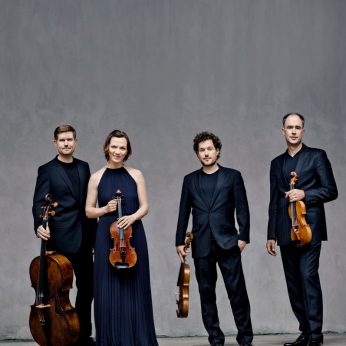Composer: Joseph Haydn (b. 1732 - d. 1809)
Performance date: 25/06/2022
Venue: St. Brendan’s Church
Composition Year: 1772
Duration: 00:22:00
Recording Engineer: Jason Fallon, Ergodos
Instrumentation: 2vn, va, vc
Instrumentation Category:String Quartet
Artists:
Signum Quartet (Florian Donderer, Annette Walther [violins], Xandi van Dijk [viola], Thomas Schmitz [cello]) -
[String Quartet]

Quartet in C major Op.20/2 [1772]
1. Moderato
2. Capriccio – Adagio
3. Minuetto – Allegretto
4. Fuga a 4 soggetti – Allegro
There are many extraordinary features.of Haydn’s opus 20 quartets; both in relation to his previous quartets and to his later ones as well. Up until now, with a few exceptions, string quartets were largely in a light gallant style. This was part of the attraction of the new classical music in contrast to the more serious, and perhaps ponderous baroque style common in the earlier part of the century.
Critics have argued that the classical style is essentially comic being derived from comic opera. In Opus 20. Haydn uses a comic style to write serious music. To be sure, there are light, humorous passages in the Opus 20 quartets typically in the finales, but the first and slow movements are generally rich, diverse, complex, emotional and often dark.
One of the many exceptional feature of the opus 20 quartets is that in three of them, the finales are fugues. The fugue was one of the typical baroque forms and is particularly associated with J.S. Bach. Although the fugue had not entirely fallen out of use in the 1770s, it was certainly regarded as old fashioned. By using the fugues in three of the opus 20 quartets, Haydn is clearly referring back to the more serious baroque style. He wanted these quartets to be taken seriously too.
With the exception of the slow movement, this quartet is jovial and optimistic. The first movement is packed with innovations. The cello opens the movement playing above the accompanying viola and second violin. As in the E flat quartet, Haydn violates the so-called rules of sonata form by modulating to unexpected keys. The development begins with a new theme with the cello and first violin answering each other over the accompanying second violin and viola. The many key changes in this movement have been regarded as a polyphonic preparation for the fugal finale.
Many of the slow movements in Opus 20 appear to be modelled on operatic arias; none more so than this Adagio Capriccio. The first half of the movement can be considered an extensive recitative, the second half an aria. The movement opens with the quartet playing forte in unison. The cello plays the theme solo while the other three instruments provide a throbbing accompaniment. There follows an extended and emotional development. Finally the first violin produces a serene cantabile subject. This would be ideal for a soprano. The first violin engages in considerable ornamentation at times in solo passages just as a soprano might show off her coloratura.
Although the minuets in Opus 20 are called minuets rather than scherzos, it is doubtful if Haydn had the slightest intention that they should be actual dances. Although this movement is in 3/4 or dance time, the main theme uses “tied” notes which go across the bar lines thus breaking up the dance rhythms.
And so to the fugal finale. If you do not know exactly what a fugue is, don’t worry, very few people do. It can be thought of as a canon with more than one theme. Musicologists now think of the fugue more as a style even as a mood, rather than as a piece of music which follows precise contrapuntal rules. This fugue has four themes or “soggetti” and the movement opens with the first theme played by the first violin. The second violin enters with the second theme. The other two themes are played by the first violin shortly afterwards. The resulting movement is witty and delicate. Having started quietly the movement ends with a loud and joyful affirmation.
David Winter
Copyright © 2024 West Cork Music. All rights reserved.
Designed and developed by Matrix Internet